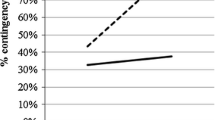Abstract
This study investigated the effects of noncontingent social reinforcement on social and academic behaviors in grade school children. Twenty-four children in the second through fifth grades were selected on the basis of teacher ratings of disruptive behavior. Subjects were divided into (a) a high social reinforcement verbal self-instructional (VSI) training group, (b) a low social reinforcement VSI group, and (c) a no-contact control group. Children in VSI groups were removed from their classrooms during four 40-minute periods and given VSI training. Significant between-groups differences on measures of social reinforcement were found indicating its successful manipulation. While none of the dependent measures indicated significant differences between experimental groups, a consistent pattern of difference scores emerged giving limited support to the hypothesis that noncontingent social reinforcement contributed to behavioral gains. Results are discussed in terms of the need for future research on the effects of rapport on treatment outcome.
Similar content being viewed by others
References
Bornstein, P. H., & Quevillon, R. P. (1976). The effects of a self-instructional package on overactive preschool boys.Journal of Applied Behavior Analysis, 9, 197–188.
Camp, B. E., Blom, G. E., Hebert, F., & van Doorninck, W. J. (1977). “Think Aloud”: A program for developing self-control in young aggressive boys.Journal of Abnormal Child Psychology, 5, 157–169.
Conners, C. K. (1969) A teacher rating scale for use in drug studies with children.American Journal of Psychiatry, 126, 884–888.
Kendall, P. C., & Finch, A. J. (1976). A cognitive-behavioral treatment for impulse control: A case study.Journal of Consulting and Clinical Psychology, 44, 852–857.
Kendall, P. C., & Finch, A. J. (1978). A cognitive-behavioral treatment for impulsivity: A case studyJournal of Consulting and Clinical Psychology, 46, 110–118.
Mehrabian, A. (1972).Nonverbal communication. Chicago: Atherton.
Meichenbaum, D. (1975). Theoretical and treatment implications of developmental research on verbal control of behavior.Canadian Psychological Review, 16, 22–27.
Padawer, W. J., Zupan, B. A., & Kendall, P. C. (1980).Developing self-control in children: A manual of cognitive-behavioral strategies. Unpublished manuscript. (Available from the author, Department of Psychology, University of Minnesota)
Parloff, B., Waskow, I. E., & Wolfe, B. E. (1978). Research on therapist variables in relation to process and outcome. In S. L. Garfield & A. E. Bergin (Eds.),Handbook of psychotherapy and behavior change: An empirical analysis (pp. 233–282). New York: Wiley.
Author information
Authors and Affiliations
Additional information
Both authors wish to express their thanks to the Missoula public school administration, principals, psychologists, and teachers. Appreciation is also due to Matthew Firpo and Anita Fisher for their help in this project.
Rights and permissions
About this article
Cite this article
Fisher, D.C., Wollersheim, J.P. Social reinforcement: A treatment component in verbal self-instructional training. J Abnorm Child Psychol 14, 41–48 (1986). https://doi.org/10.1007/BF00917220
Revised:
Issue Date:
DOI: https://doi.org/10.1007/BF00917220




